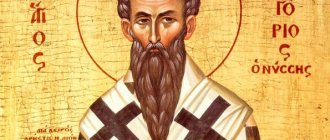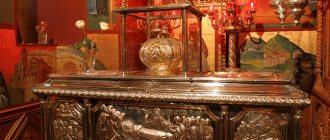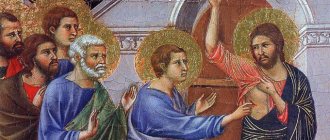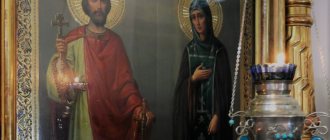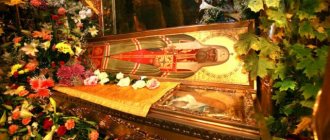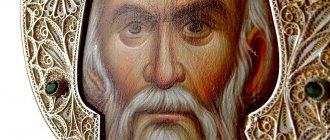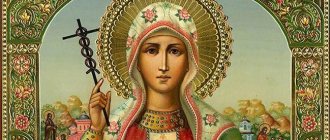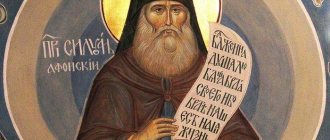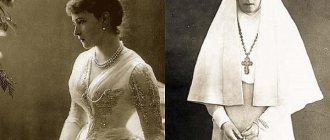| Sschmch. Dionysius the Areopagite. Icon |
Dionysius the Areopagite
(c.), Bishop of Athens, Hieromartyr Commemoration of October 3 and the Council of the 70 Apostles
Lived in the city of Athens. There he was brought up and received a classical Hellenic education. Then he went to Egypt, where he studied astronomy in the city of Iliopolis. Together with his friend Apollophon, he witnessed a solar eclipse at the time of the crucifixion of the Lord Jesus Christ. “It is either God, the Creator of the whole world, who suffers, or this visible world ends,” Dionysius said then. In Athens, where he returned from Egypt, he was elected a member of the Areopagus (the supreme court of Athens).
When the holy Apostle Paul preached in the Athenian Areopagus (Acts 17: 16 - 34), Dionysius accepted this saving gospel and became a Christian.
In Acts. 17, 34, together with Dionysius the Areopagite, Damara is mentioned, whom some consider the wife of Dionysius.
For three years, Dionysius was a companion of the holy Apostle Paul in preaching the Word of God. Subsequently, the Apostle Paul made him bishop of the city of Athens. In the year Saint Dionysius was present at the burial of the Most Holy Theotokos.
Even during the life of the Mother of God, Dionysius the Areopagite, who specially came to Jerusalem from Athens to see the Mother of God, wrote to his teacher the Apostle Paul:
“I am testified by God that, besides God Himself, there is nothing in the universe so filled with Divine power and grace. No man can comprehend with his mind what I saw. I confess before God: when I was brought before the face of the Blessed Virgin by John, shining among the apostles, like the sun in the sky, I experienced an inexpressible feeling. Some kind of Divine radiance shone before me. It illuminated my spirit. I felt the fragrance of indescribable aromas and was filled with such delight that neither my weak body nor my spirit could bear these signs and the firstfruits of eternal bliss and Heavenly glory. From Her grace my heart fainted, my spirit fainted. If I had not remembered your instructions, I would have considered Her to be the true God. It is impossible to imagine greater bliss than what I felt then.”
| The Torment of St. Dionysius the Areopagite. Fresco. Athos, Dionysiates Monastery (1547 by Zorzis Fuka) |
He died a martyr's death (according to ancient news, based on the testimony of the apologist Aristides). There is an opinion dating back to the Middle Ages, according to which Dionysius the Areopagite was a preacher of Christianity in Gaul (See Dionysius of Paris).
Proceedings
The question of the writings attributed to Dionysius the Areopagite is very important. The first indication of his writings is found in c. At the dispute between the Severian Monophysites and the Orthodox, organized by the emperor. Justinian in 533, the Monophysites, arguing against the Council of Chalcedon, referred, among other things, to the works of Dionysius the Areopagite and to the objection of the Orthodox that neither the saints knew such works. Athanasius the Great, nor St. Cyril of Alexandria, who fought against Nestorius, answered that St. Cyril cited them in his writings against Diodorus of Tarsus and Theodore of Mopsuet. Later, both the Monophysite Severus of Antioch and the Orthodox Antiochian Patriarch Ephraim referred to the works of Dionysius, and John of Scythopolis wrote interpretations of them. From then on, the writings of Dionysius acquired high respect in the Greek Church. Rev. Maximus the Confessor commented on them, Pachymer (XIII century) compiled a paraphrase of them.
| St. Dionysius the Areopagite. Icon of the work of the priest. Parthenia (Kankellariou), 1729, Athens. Collection of the Museum of Icons, Venice. |
For the first time in the West, Pope Gregory the Great refers to the works of Dionysius, namely the work “Heavenly Hierarchy”.
Imperial The Byzantine Michael the tongue-tied sent a copy of the works of Dionysius to Louis the Pious (827), and they soon acquired special respect in the West, which, perhaps, was facilitated by the fact that Dionysius the Areopagite was credited with preaching in Gaul, where they said he suffered. John Scotus Erigena, on behalf of Charles the Bald, translated the works of Dionysius and their interpretations into Latin. Subsequently, in the West, Dionysius became the leader of the mystical trend in theology: he was diligently studied by Hugon of Saint-Victor; Albert the Great, Thomas Aquinas and others. The opinion that St. Dionysius the Areopagite and St. Dionysius of Paris - different persons, probably going back to the statements of Pierre Abelard, later found in Lorenzo Valla and Erasmus of Rotterdam. At the same time, objections were raised to the antiquity of the writings attributed to St. Dionysius the Areopagite. Since then, these objections have not ceased: both Protestant and Catholic historians do not find it possible to attribute the writings known under the name of Dionysius the Areopagite to the writing of the apostolic men.
According to scientific critics, the works attributed to Dionysius the Areopagite: “On the heavenly hierarchy - περί της ούρανίας ίεραρχίας”; “On the church hierarchy - περί της εκκλησιαστικης ίεραρχίας”; “About the names of God - περί θείων όνοματων”; “On mysterious theology - περί μυστικης θεολογίας “10 letters to different persons” - could have been written at the end or at the beginning of the century by a Christian Platonist. This does not, however, cast a shadow on the very content of the works. Authorities such as Maximus the Confessor and John of Damascus serve as guarantees that they contain true and sound Church teaching.
DIONYSIUS AREOPAGITE
In the will of Bishop. Perpetua of Turon (Ɨ 490) mentions that the bishop handed over a silver cross, into the handle of which were embedded particles of the relics of Dionysius, c. St. Dionysius in the village. Rambascisk. This is the first mention of the relics or other relics of St. Dionysius outside the Parisians (Perpetuus Turonensis. Testamentum // PL. 58. Col. 754; 71. Col. 1151; Greg. Turon. Hist. Franc. X 31).
The liturgical books from Saint-Denis name a number of holidays associated with the relics of D. A. Some of them were celebrated not only in the Epoch of Paris, but throughout France. In memory of the discovery of the relics of D. A. at Frank. cor. A holiday was established for Dagobert I on April 22. A. du Saussey in the Gallic Martyrology (1636) argued that this holiday was dedicated to the “revelation” of Catulais about the relics of D. A. The memory of the discovery of the relics of the saint in the Gallic Martyrology is placed under May 22, and the memory of the 1st discovery of the relics of Catulais - on March 23. In fact, we are talking about the discovery of the relics under Dagobert I, which in various liturgical collections was placed under these 3 dates, representing the 10th day before the calendar of the next month. Probably, du Saussey discovered information about these memorial holidays in various manuscripts and correlated them with events from the history of the relics of D.A.
Under July 28, the liturgical collections include a holiday established in memory of D. A.’s vision of Pope Stephen II. In the Parisian calendar of 854 the same festival is mentioned under July 15 as “the extraction of the relics of St. Dionysius." In the VIII-IX centuries. There was a tradition of celebrating on July 28 the memory of the consecration of the church in Saint-Denis at Cor. Pipina Short (754). The transfer of the relics of D. A., Rustik and Eleutherius to Saint-Denis was also celebrated on February 17. and is mentioned in martyrologies of the 16th-17th centuries.
The relics of D. A. were repeatedly transferred by the monks for fear of desecration of the shrine by the Normans. In 759, the relics were hidden in the monastery estate of Noviak in the Mavripensky Pag, not far from modern. Troyes, in 877 - at the monastery villa Curtis Superior on the river. Axona (modern Aina), in 886 - in Reims. The Reims canon Flodoard in the “History of the Reims Church” (10th century; Flodoardus. Historia Remensis ecclesiae. IV 48), as well as the compiler of the Reims Chronicle (11th century), report miracles from the relics of the saint that occurred during their stay in Reims. In the collection of miracles of D.A., dedicated to mon. Samuel, mentions the presence of the relics of D. A. in the camp of the emperor. Charlemagne during the war with the Saxons (772-804).
Dormition of the Most Holy Mother of God. Back of the Don Icon of the Mother of God. Master of the Circle of Theophanes the Greek. 80–90s XIV century (Tretyakov Gallery) Dormition of the Most Holy. Mother of God. Back of the Don Icon of the Mother of God. Master of the Circle of Theophanes the Greek. 80–90s XIV century (TG)
In the Life of St. Gerhard of Bronsky († 959), who lived for some time in Saint-Denis, says that the monk took from there “relics” of D.A., including a portable altar, on which, according to local legend, D.A. was celebrating the last Eucharist in prison when Christ appeared to him (Hilduinus. Passio. 29). In the beginning. XI century Goscelin, abbot of the Fleury monastery (modern Saint-Benoit-sur-Loire), sent mon. Helgoda to Paris to cor. Robert the Pious. The king gave him “from their robes, stained with blood,” a piece of D. A.’s robe, the dalmatic of St. Rustic, chasuble of St. Eleutheria, “dust from their bodies,” “part of the triple fetters by which St. Dionysius." The relics were given for storage in the center. in the name of D. A. in the Fleury monastery. At the same time, St. Bernward, Bishop The city of Hildesheim (Germany), received from the monks of Saint-Denis “relics” of D.A., which were placed by the saint in the Hildesheim Cathedral. The word “relics” could designate any object associated with the name of a saint, not necessarily the relics of D. A. Until 1053, particles of the saint’s neck bones were kept in the monastery of Vergis (historical region of Burgundy), but the origin of the shrine is unknown. Franz. historian Rigord in op. “The Acts of Philip Augustus” (beginning of the 13th century) wrote that particles of the relics of D. A. were kept in Vergis and in Rome, where they were brought by Pope Stephen II, while the rest of the relics of the saint were in Saint-Denis.
All R. XI century a controversy began between the monasteries of Saint-Denis and St. Emmeram in Regensburg (Germany), which concerned the issue of possessing the original relics of D. A. Reginvard, abbot of the monastery of St. Emmeram (1049-1064), during construction work in monastery church discovered an inscription carved on a stone. It reported that in the temple rested the relics of D. A., taken from Saint-Denis during the German reign. imp. Arnulf (king of the East Franks in 888-899), cor. zap. Franks Odone (888-898) and abbot of the monastery of Ebulone. After the discovery of the relics, Otlokh of St. Emmeram composed a legend about the transfer of the shrine to Regensburg. The legend says that the lawful cor. zap. Franks Charles the Simple was removed from power by the Hertz. Odon and arrived in Cologne to the cor. Arnulf, asking for his help. Arnulf invaded the western kingdom. Franks and reconciled the opponents. He stopped near Paris and visited the monastery of Saint-Denis. Abbot Ebulon gave him the book. “On the Heavenly Hierarchy,” reading it, the king was amazed at the greatness of the saint and wished to receive his relics. One of Arnulf's close associates and Ebulon's relative, Gislibert, agreed to help the king. He gained the trust of the abbot and inspected the crypt where the relics of D. A. In the evening, during a feast in the monastery, Gislibert bribed the guardians of the shrine, stole the relics and at night fled to the camp of Arnulf. The next morning, having learned about the loss, Ebulon arrived to the king. Arnulf promised to find and return the stolen shrine. In order to avoid a scandal, the king advised the abbot to place the remains of another saint in place of D. A.’s relics, which, according to Otlokh, was done by Ebulon. Out of reverence for D. A. Arnulf always carried the relics of the saint with him, and before his death he transferred them to the monastery of St. Emmer. Bishop of Regensburg Tuton (893-930) ordered the relics to be walled up in the wall of the church, covering them with stone slabs with an inscription certifying the authenticity of the shrine.
There are a number of historical inconsistencies in Otlokh's story. Charles the Simple was anointed king in 892, but did not receive real power in the western kingdom. francs and turned to Cor. for help. Arnulf (893). Arnulf recognized Charles's royal dignity, but refused him military support. In 895 Arnulf also recognized the royal dignity of Odon. An agreement between Charles and Odon was concluded in 897 without the direct intervention of Arnulf. According to Otloch, the relics were stolen from Saint-Denis in 893. Abbot Ebulon died in the same year, but back in 892 he took the side of Charles the Simple, was expelled from Saint-Denis by Odon and fled to Aquitaine, where he died.
Martyrdom sschmch. Dionysius the Areopagite. Fragment of an altar painting. Artist J. Maluel. Beginning XV century (Louvre, Paris)
Martyrdom sschmch. Dionysius the Areopagite. Fragment of an altar painting. Artist J. Maluel. Beginning XV century (Louvre, Paris)
In 1053 cor. Henry I of France ordered the examination of the relics of D. A. in Saint-Denis in order to refute the claims of the monks of St. Emmeram. Rigaard mentions this in Op. "The Acts of Philip Augustus" (ActaSS. T. 4. Col. 967). Rigaard reports that when rumors of the discovery of the relics of D.A. in Regensburg reached Paris, cor. Henry I sent to Germany. imp. Henry III (1046-1056) envoys with a request to postpone the opening ceremony of the relics until the results of the examination of the shrine in Saint-Denis are received. The Emperor agreed and sent representatives to France. In their presence, in Saint-Denis, an autopsy was performed on D. A.’s shrine, in which the saint’s relics were discovered intact, except for the neck bones, which were kept in Vergis, and part of the hand, transferred by Pope Stephen II to Rome. However, the Germans declared that the relics of another saint rested in the shrine. According to the testimony of the “Saxon Annalist” (beginning of the 12th century), in 1052 Pope Leo IX arrived in Regensburg, who allegedly recognized the relics found there as authentic (Ibid. Col. 973). 2 forged messages from Pope Leo IX to the French were compiled. cor. Henry I, confirming the authenticity of the relics of D. A. in Regensburg (Ibid. Col. 975-977), as well as a detailed legend from the French. mon. Gaimon about the discovery of relics in Saint-Denis (beginning of the 13th century). He refuted the claims of the monks of St. Emmeram to possess the relics of D. A. and denied that the authenticity of the relics was confirmed by Pope Leo IX. The dispute between the monasteries of Saint-Denis and Saint-Emmeram ended only at the end. XIX century, the veneration of relics in Regensburg ceased.
In the 12th century Abbot of Saint-Denis Suger carried out a complete reconstruction of the monastery complex. On the site of the old Carolingian basilica, a new church was built; in its lower temple the relics of D. A., Rusticus and Eleutherius, as well as other saints, were kept. D. A.’s relics were placed in a new shrine. Afterwards they were repeatedly exhibited for public veneration in front of the main altar of the upper temple, and were also temporarily transferred to Paris at the request of the king or members of his family. In 1244, the relics of D. A., Rustik and Eleutherius were brought to Paris due to a serious illness of the core. Louis IX Saint at the request of his mother cor. Forms. This event made a great impression on the residents of the city (Ibid. Col. 944-945). According to Rigord, the relics of D. A. were first transferred to the upper temple of Saint-Denis on July 23, 1191 due to the illness of the son of Cor. Philip II Augustus Louis (later cor. Louis VIII). Under the new royal dynasty of Valois, this custom was strengthened. In 1335, due to the illness of the son of Cor. Philip VI, John, Hertz. Normandy, the relics of D. A. were brought to Paris, and the patient, having kissed the cancer, received healing (Ibid. Col. 943-944). In 1191, for the sake of prayers for Cor. Philip II Augustus, who was on the 3rd Crusade (1189-1192), on the main altar c. A golden crown from the saint's shrine was displayed to Saint Denis. The head of D. A., placed in a silver reliquary, was left on the main altar of the church for the veneration of pilgrims and prayers for the king. A new reliquary for her was made by Cor. Philip III (1270-1285). In the 12th century a custom arose to consecrate the French battle flag at the relics of D. A. kings - oriflamme.
In the 12th century canons of the Cathedral of St. The Virgin Mary (Our Lady of Paris) announced that they had part of the head of D. A. Rigord and his successor William of Breton refuted this statement, explaining that, according to the Life, the head of D. A. was not cut in two during execution. However, in the 12th century. in zap. In iconography, images of the martyrdom of D. A. appeared, in which the saint’s head is cut in half with a sword or axe. It is likely that this iconography prompted the Parisian canons to declare ownership of part of the saint's head (Ibid. P. 949-950). The dispute continued until the 2nd floor. XIV century, when Cor. Charles V (1364-1384) invited the dean and senior canons of the chapter of Notre Dame to Saint-Denis and showed them the chapter of D. A., kept in the abbey. The king demanded that the canons not confuse the people by passing off the remains of an unknown person as the relics of a saint. However, with cor. The Parisian canons presented Charles VI (1384-1422) with a piece from the chapter of D. A. Hertz that they kept. Berry, who had previously unsuccessfully tried to obtain a piece of the saint’s relics from the monks of Saint-Denis. By order of the king, the monks of Saint-Denis organized processions with the authentic head of D.A. throughout the bishopric of Paris to show everyone that the original shrine was kept in Saint-Denis. The Paris parliament began to sort out the litigation between the monks of Saint-Denis and the canons of Notre Dame Cathedral. 19 Apr In 1410, the final decision was made that the head of D.A., bishop. Athens, is located in Saint-Denis, and the head of the schmch is kept in the Cathedral of Notre Dame in Paris. Dionysius, bishop Corinthian. This decision had nothing to do with reality, but back in the 18th century. it was read in all the churches of the diocese of Paris in the octave after the day of memory of D. A.
According to the Jesuit Allois, in the 17th century. part of the chapter of D.A. was also kept in the village. Egel in the Dukedom of Luxembourg. The origin of the relic is unknown. Local residents consecrated water and wine at part of the head of D.A., which were considered healing, relieving headaches. On the top of the head was depicted a white cross, according to legend, inscribed by St. Paul at the ordination of D. A. as bishop.
Some of the relics of D.A. were allegedly also in the village. Ridrefeld (modern Rotherfield, East Sussex, UK). However, information about her is based on a fake Hertz diploma. Offa Bertualda (fake, possibly 13th century). It tells how Bertuald could not recover from a serious illness for a long time and, having learned that in Parisia there were the healing relics of D.A., he went there to worship. Having received healing, Bertuald begged the abbot of Fulrad for particles of relics, which he placed in the church. St. Dionysius, built by him on the Riedrefeld estate. The beginning of the veneration of D. A. in England is indeed associated with the name of Bertualda. The basis for Berthuald's forged charter was the original diploma of the correspondent. Offa's Mercia (790), in which Berthwald's illness and healing are also reported, but there is no information about the temple and relics of D.A. in Ridrefeld (ActaSS. Oct. T. 4. Col. 939, 945-946). In 1059 English. cor. Edward the Confessor mentioned the “glorious here” (i.e. in England) memory of D. A.
Particles of the relics of D. A. were transferred from Paris to Prague in 1378. imp. Charles IV, along with particles of the relics of other saints. They were placed in the Cathedral of St. Vita. Pope Innocent VI, at the request of the emperor, approved the conciliar celebration on January 2. in honor of all the saints whose relics are in the church of St. Vita.
From the 4th Crusade (1202-1204) card. Peter of Capua brought the relics of the Scheme from Greece to Rome. Dionysius of Corinth. After the death of card. Peter's (1209) Pope Innocent III handed over the relics to Emeric, prior of the monastery of Saint-Denis, who arrived at the VI Lateran Council (1215). In a special bull, Pope Innocent explained that the relics may belong to D. A., “for some believe that Dionysius the Areopagite died and was buried in Greece and that there was another Dionysius who preached the faith of Christ to the people of the Franks; others claim that the first (Areopagite) after the death of Blessed Paul arrived in Rome and was sent by Holy Pope Clement to Gaul, and the second died and was buried in Greece. However, both are great in deeds and glorious in words.” According to Pope Innocent, in order to avoid confusion, the relics of both Saints Dionysius should rest in one place.
There is a legend that after the 4th Crusade, another chapter of D.A. appeared in the West, taken from K-field by a participant in the campaign, Bishop of Soissons. Nivellon. Nivellon later gave it to the Cistercian monastery of Lonpon. However, this legend is not supported by documents. The history of the transfer of the chapter of D.A. to Lonpon is based on liturgical readings from the Soissons Breviary of the con. XV century A celebration in honor of this event was held in the diocese of Soissons on the 1st Sunday after the day of remembrance of D. A. In 1690, the prior of the Lonpon monastery, S. J. Cotte, opened the reliquary and described in detail the relics stored in it. A small silver casket with armor was found in the shrine. an inscription certifying the authenticity of the relic. The casket contained fragments of bones and the front part of the skull, on which there was a Greek word. inscription: κεφαλη του αγιου Διονυσιου Αρεοπαγιτ (head of St. Dionysius the Areopagite). However, in Byzantium. sources have no information about the chapter of D.A., allegedly kept in the K-field. Probably the Greek inscription on the skull was made by order of Bishop. Nivellon.
In 1793, the Abbey of Saint-Denis was closed, the royal tombs in the temple were destroyed, but the relics of D. A. survived. In 1802, services began to be held in the church again. Currently the relics of D.A., Rustica and Eleutheria are kept in reliquaries behind the main altar of the Basilica of Saint-Denis. Since 1997, Orthodox services have been performed at the shrine. prayer services. During archaeological excavations (1953-1973), under the altar of the basilica, the supposed original grave of D. A. was discovered. Back in 1947, a carved column was found, which in the Merovingian era formed part of the tomb of D. A. In the parish church of the village. Saint-Denis (near Mons, Hainaut Province, Belgium) contains parts of the relics of saints, donated in 1665 by the Parisian Abbey of St. Genovefs to the local mon-rue of St. Dionysius (Saint-Denis-en-Brocroix). They were considered lost during the French Revolution, but were rediscovered in 1998. In the crypt of the parish church of the village. La Celle Conde (dept. Cher, France) is a revered place where, according to legend, the relics of D.A. were once kept.
Parts of D.A.’s relics were also located in a number of eastern regions. churches and monasteries. On Mount Athos, in the Dokhiar monastery, part of the chapter of D.A. is venerated; in the Simonopetra Monastery - part of a hand; in the monastery of Dionysiatus - a piece of the skin of a saint (Meinardus OA Study of Relics of Saints of the Greek Orthodox Church // Oriens Chr. 1970. Bd. 54. S. 170).
Source: ActaSS. Oct. T. 4. Col. 865-887; Maximus Conf. Schol. in DN: Prologus // PG. 4. Col. 16-21; Venantius Fortunatus. Passio S. Dionysii, Rustici et Eleutherii // PL. 88. Col. 577-583; idem. Carmina. II 10 // Ibid. Col. 98-99; Hilduinus. Vita S. Dionysii // PL. 104. Col. 1326-1330; 106. Col. 13-30; Epistula Aristarchi Honisiforo // ActaSS. Oct. T. 4. Col. 701-705; Anastasius Bibliothecarius. Passio S. Dionysii // PL. 129. Col. 737-739; Methodius (Metrodorus). Martyrium beati Dionysii Areopagitae // PG. 4. Col. 669-684; Michael Syncellus. Encomium beati Dionysii Areopagitae // Ibid. Col. 617-668; Symeon Metaphrastes. Vita et conversatio S. Dionysii Areopagitae // Ibid. Col. 589-608; 115. Col. 1032-1049; Petrus Abaelardus. Epistula de Dionysio Areopagita // PL. 178. Col. 311-344; SynCP. P. 102.8-14; Kugener MA Une autobiographie syriaque de Denys l'Aréopagite // Oriens Chr. 1907. Bd. 7. S. 292-348; Suda. 1938, 1984r. Vol. 2. P. 106-109; Peeters P. La vision de Denys l'Aréopagite à Héliopolis // AnBoll. 1910. Vol. 29. P. 302-322; idem. La version ibéro-arménienne de l'autobiographie de Denys l'Aréopagite // Ibid. 1921. Vol. 39. P. 277-313.
Lit.: BHL, N 2171-2203; BHG, N 554-558; BHO, N 255-256; CPG, N 6633; Aubert R. Denys // DHGE. Vol. 14. Col. 263-265; Spadafora F. Dionigi l'Areopagita // BiblSS. Vol. 4. Col. 634-636; Clerq C., de, Burchi P., Celletti MC Dionigi, Rustico ed Eleuterio // Ibid. Col. 650-661; Hipler F. Dionysius, der Areopagite: Untersuch. über Aechtheit und Glaubwürdigkeit der unter diesem Namen vorhandenen Schriften. Regensburg, 1861; Delehaye. Origins. P. 358 sq.; Eine dem Dionysius Areopagita zugeschriebene Schrift in koptischer Sprache // Bull. de l'Académie Impériale des Sciences de St.-Pétersbourg. St.-Pb., 1900. 5 ser. T. 12. P. 268-306; Marr N. Ya. Hagiographic materials on cargo. Iver's manuscripts // ZVORAO. 1901. T. 13. No. 2/3. pp. 1-144; Duchesne. Fastes. Vol. 2; Akinian N. Materialien zum Studium des armenischen Martyrologiums. W., 1914. S. 35-42; Levillain LS Trophime et la mission des Sept en Gaule // Revue de l'histoire de l'Église de France. P., 1927. Vol. 13. P. 145-189; Chevallier Ph. Dionysiaca: Recueil donnant l'ensemble des traductions latines des ouvrages attribués à Denys de l'Aréopage. P., 1937, 19502. 2 vol.; Crosby S. McK. The Abbey of St. Denis: 475-1122. New Haven, 1942. Vol. 1. P. 24-52; Moretus-Plantin H. Les Passions de S. Denys // Mélanges Cavallera. P., 1948. P. 215-230; Loenertz LI Le panégyrique de St. Denys l'Aréopagite par St. Michel le Syncelle // AnBoll. 1950. Vol. 68. P. 94-107; idem. La légende parisienne de S. Denys l'Aréopagite: Sa genèse et son premier témoin // Ibid. 1951. Vol. 69. P. 217-237; Dondaine H. Le Corpus dionysien de l'Univ. de Paris au XIIIe siècle. R., 1953; Bossuat R. Traditions populaires relatives au martyre et à la sépulture de S. Denys // Le Moyen Âge. 1956. Vol. 62. P. 479-509; Faes de Mottoni B. Il "Corpus Dionysiacum" nel medioevo: Rassegna di studi: 1900-1972. R., 1977; Louth A. Denys the Areopagite. L., 1989; Contamine Ph. Des pouvoirs en France: 1300-1500. P., 1992. P. 49-60; Denys l'Aréopagite et sa postérité en Orient et en Occident / Ed. Y. de Andia. P., 1997.
D. V. Zaitsev
Prayers
Troparion, tone 4
Having learned goodness and become sober in all,/ you have wrapped yourself in a sacred conscience with a good conscience,/ you have drawn from the chosen ineffable vessel/ and, having observed the faith, you have accomplished an equal course,/ priest Dioni This,/ pray to Christ God// for our souls to be saved.
Kontakion, tone 8
(Similar to: Taken:)
The gates of heaven passed through the spirit like a disciple / until the third Heaven reached the apostle, Dionysius, / the ineffable ones were enriched with all intelligence / and you shone in the darkness of ignorance niya./ We also call: Rejoice, universal father.
After accepting Christianity
Under the leadership of the Primate of the Church of Athens, Hierotheos, Dionysius studied Christianity for a short time and showed such impressive success that the Apostle Paul ordained him to the rank of bishop instead of Hierotheos himself, who left Athens in order to carry the word of Christ to other countries. Naturally, the Athenian Church, under the leadership of the new bishop, began to develop rapidly. However, literally in the fifty-eighth year from the Nativity of Christ, Dionysius the Areopagite went to the city of Jerusalem, where, at the inspiration of the Holy Spirit, the Apostles and their companions from all other countries gathered. Therefore, he quickly had to leave the bishopric in Athens.
Literature
- D. V. Zaitsev. A. A. Turilov, E. P. I., T. Yu. Oblitsova. “Dionysius the Areopagite” // Orthodox Encyclopedia, vol. 15, p. 309-324
About the works of Dionysius the Areopagite
- Prot. John Meyendorff. Pseudo-Dionysius Areopagite
- Bolotov V.V. On the issue of Areopagite creations. St. Petersburg, 1914 (pdf)
- About Saint Dionysius the Areopagite and his creations. From Christian Reading magazine. 1848
- Archim. Rafail (Karelin). Subverters of Saint Dionysius the Areopagite
- "St. Dionysius the Areopagite and false Orthodox theology"
Curriculum Vitae
About the saint and philosopher of the first century A.D. information is preserved in the Acts of the Saints.
Origin of the saint
Saint Dionysius the Areopagite was born in Greece, in Athens, into a noble family. He showed great ability in studying the classical sciences of that time. He continued his education in Heliopolis (Egypt). Upon returning to Athens, the brilliantly educated young man was elected to the Supreme Court of Athens (Areopagus).
Life of the Hieromartyr
The Apostle Paul, who arrived in Greece to convert pagans to Christianity, was summoned to the Areopagus to explain the essence of the doctrine. The apostolic preaching had a huge influence on Dionysius. He was baptized and for 3 years was Paul's companion in his apostolic ministry.
Dionysius specially came to Jerusalem to see the Mother of God. He wrote to his teacher about his impression that he had experienced Divine grace emanating from the Mother of God. In 57, the Areopagite was present at the burial of the Holy Virgin Mary. Dionysius became the first bishop of Athens. Under Emperor Nero, persecution of Christians and the revival of paganism began. The apostles Paul and Peter were captured in Rome and executed.
Demise
After the death of Paul, Saint Dionysius took upon himself the responsibility to continue his work. Together with the clergy Rusticus and Eleutherius, he went to preach in European countries: Italy, Spain, Germany, France (Gaul).
In the Roman settlement of Lutetia (Paris would be founded here in the future), three preachers were captured and thrown into prison, where they were tortured. After refusing to renounce their Christian faith, they were sentenced to death. At night, the saint performed the liturgy in the presence of angels. In the morning the martyrs were beheaded.
As legend testifies, the body of Dionysius stood up, took the severed head in his hands and went to a Christian temple 6 kilometers from Lutetia, thus indicating the place of his burial. The remains of the saint were buried by a pious woman named Catulla. Subsequently, the place was named Saint-Denis.
Book “On the Heavenly Hierarchy”
This essay occupies a very interesting position. This work contains some evidence from the Gospel and the Apocalypse of John. This suggests that this work was written no earlier than the beginning of the first century after the Nativity of Christ, not in Athens, but already in Western countries. The book itself is divided into fifteen chapters. First of all, before narrating the heavenly mysteries, Dionysius the Areopagite first prays to the Lord with a request to let him understand the symbols under which the angels and their ranks are represented in the Holy Scriptures. Then the necessity of the symbols themselves in the description of both church rites and angelic ranks is explained, since our mind is not able to penetrate these secrets in any other way. But these symbols cannot be taken literally, since the divine world is incorporeal. By the way, Dionysius the Areopagite says the same thing about divine names - these are all abstract symbolic reflections of one or another manifestation of the Lord.
Angelic ranks
Actually, the name “angel” refers in the works of such an author as Dionysius the Areopagite only to the lower heavenly ranks, but it can still be correlated to some extent with the higher ones, since they have all the powers of the lower ones. The holy hierarchy is divided into three degrees. In the first - Cherubim, Seraphim and Thrones. In the second - Dominance, Strength and Authority. In the third - Archangels, Angels and Principalities. There are nine ranks in total. Features of the first (highest) degree are interpreted based on their names. Seraphim - flaming, Cherubim - wise, Thrones - are located directly at the throne of the Lord (as they say further, receiving purity and perfection from him). Powers, Strengths and Dominances (the next ranks) are also revealed through their names. It is said that they are improved and enlightened through insights sent down from higher ranks, and also pass them on to lower ones. Divine providence, passing from one messenger to another, weakens over time. The Principalities, Angels and Archangels rule over human institutions and protect people. Then, in his work, Saint Dionysius the Areopagite describes and explains the symbols that are used in Holy Scripture to describe the Kingdom of Heaven.
